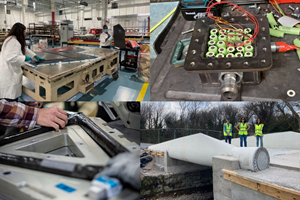HPC goes to SPE ACCE
CT Editor-in-chief Jeff Sloan fields initial reports from two CT staffers about the recent — and growing — Society of Plastics Engineers' Automotive Composites Conference and Exhibition.
This year, the Society of Plastics Engineer’s Automotive Composite Conference & Exhibition (ACCE) was relocated from the outgrown Michigan State University Management Education Center (Troy, Mich.) to the Suburban Collection Showcase in nearby Novi. A good thing. ACCE exhibitors doubled, and last year’s record 630 attendees paled compared to the 897 registered this year — one indication that auto OEMs could be ready for pervasive use of composites. CT staffers went looking for answers to the question I asked in my August editorial: Are we ready? The best answer may be, We know what we need to do to be ready.
Managing editor Mike Musselman says many at ACCE considered that very question. ACCE co-chair Ed Bernardin (Siemens PLM Software) said the auto industry’s characteristic high rate of change is a key hurdle. He and Roger Assaker (e-Xstream engineering) contended that virtual testing of composites is a huge need in the auto world. Such tools are well developed for chopped-fiber compounds, but there is a pressing need for software that can simulate failure of continuous-fiber composites. Reliable tools are emerging and will, says Assaker, take a two-year, multimillion dollar testing program and compress it into a long work day!
High-pressure RTM (HP-RTM), the subject of multiple research reports at last year’s ACCE, is now commercial: Shuler SMG GmbH’s vacuum-assisted HP-RTM system mints the BMW i3 passenger cell and the BMW M3 roof. Quickstep Technologies proposes to do similar duty at low pressures (and with less expensive equipment), with the aid of fluid heating and its new Resin Spray Technology (RST). And Volkswagen AG’s Hendrik Mainka said his work with Oak Ridge National Lab shows that lignin precursor and the process of oxidation and pyrolization that converts it to carbon fiber spells cost savings of 40 percent. Unfortunately, unresolved issues, among them the seasonal variation in lignin (as a plant product), mean commercialization could be a decade away.
CT senior technical editor Sara Black points out that ACCE’s “Aluminum & Composite — Compete or Collaborate?” panelists included aluminum industry representatives. All the panelists agreed that composites can 1) displace steel and aluminum in appropriate applications, and 2) make invaluable contributions to lightweighting. But the discussion revealed that auto OEMs will remain resistant until they hear a valid value proposition. If a composites solution for automotive can make a part lighter, for less money, no problem, say the OEMs. Such solutions, so far, are scarce — a notable exception is the semi-convertible sunroof frame for the Citroen DS3 Cabrio, molded from a modified glass-reinforced styrene maleic anhydride (SMA) resin. The part offers significant material cost savings, part integration (seven parts combined into one) and a 40 percent weight reduction. That aside, Kaiser Aluminum’s Doug Richman made the point that without a solid business case, it’s impossible to make the technology case. Panelist Jai Venkatesan of Dow Chemical Co., pointed out in his keynote address that adoption of composites is a “high-risk, high-reward” and disruptive step, and it’ll take time. Yet, he believes that we can use lessons learned from veterans of aerospace composites and automotive aluminum, apply software tools more widely, and — in collaboration — eventually ensure that composites become an entrenched material choice.
Related Content
Why aren't composites synonymous with infrastructure?
The U.S. seems poised to invest heavily in infrastructure. Can the composites industry rise to the occasion?
Read MoreAs 2023 begins, a look back at trending CW topics in 2022
With 2022 now behind us, CW’s editor-in-chief Jeff Sloan takes a look at the CW stories last year that received the most reader attention.
Read MoreThe future of carbon fiber manufacture
Later this month, CW’s 25th anniversary Carbon Fiber Conference promises to be among the most important as dynamic market forces are putting unusual pressure on the carbon fiber supply chain.
Read MoreHow composites have become a necessity
Composites used to be one of many material options across industries and applications, but that's not the case anymore.
Read MoreRead Next
From the CW Archives: The tale of the thermoplastic cryotank
In 2006, guest columnist Bob Hartunian related the story of his efforts two decades prior, while at McDonnell Douglas, to develop a thermoplastic composite crytank for hydrogen storage. He learned a lot of lessons.
Read MoreComposites end markets: Energy (2024)
Composites are used widely in oil/gas, wind and other renewable energy applications. Despite market challenges, growth potential and innovation for composites continue.
Read MoreCW’s 2024 Top Shops survey offers new approach to benchmarking
Respondents that complete the survey by April 30, 2024, have the chance to be recognized as an honoree.
Read More





















